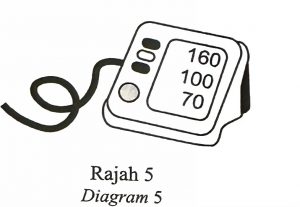Question 5:
Diagram 5 shows the reading on digital sphygmomanometer for an adult.

(a) Based on Diagram 5,
(i) state the unit used in the tool [1 mark]
(ii) state one health problem that might be suffered by the adult [1 mark]
(iii) suggest two ways to decrease the risk of health problem stated in 5(a)(ii). [2 marks]
(b) Table 2 shows the information related to the blood pressure of two individuals for a prolonged period.
 Based on Table 2, both individuals have different types of blood pressure diseases. Differentiate between individual P and individual Q from the aspect of:
Based on Table 2, both individuals have different types of blood pressure diseases. Differentiate between individual P and individual Q from the aspect of:
(i) type of diseases
(ii) blood pressure when the heart muscles are contracting dan relaxing.
[2 marks]
Answer:
(a)(i)
Millimetres of mercury
Explanation:
Millimetres of mercury is the unit of measurement for the sphygmomanometer
(a)(ii)
Hypertension // High blood pressure
Explanation:
A high blood pressure reading (160 / 100 mmHg) indicates that the individual may have hypertension.
(a)(iii)
– Reducing the intake of salt, saturated fats, and sugar, while increasing the consumption of fruits, vegetables, and whole grains.
– Engaging in regular physical activity to help lower blood pressure and improve heart health.
Explanation:
Adopting a healthy diet and engaging in regular physical activity are essential as both can help control blood pressure and reduce the risk of heart disease. A nutrient-rich diet supports cardiovascular health, while physical activity enhances blood circulation and strengthens the heart.
(b)(i)
Individual P has hypotension (low blood pressure) while individual Q has hypertension (high blood pressure)
Explanation:
Individual P has hypotension (low blood pressure) as their blood pressure reading is 85 / 60 mmHg, which shows symptoms like blurry vision and paleness. Individual Q has hypertension (high blood pressure) as their blood pressure reading is 180 / 110 mmHg, which shows symptoms like irregular heartbeat and severe headaches.
(b)(ii)
Blood pressure when hear muscle are
– contract: 85 mmHg for individual P while 180 mmHg for individual Q .
– relax: 60 mmHg for individual P while 110 mmHg for individual Q .
Explanation:
Systolic pressure indicates the pressure in the arteries when the heart contracts, while diastolic pressure indicates the pressure in the arteries when the heart relaxes.
Diagram 5 shows the reading on digital sphygmomanometer for an adult.

(a) Based on Diagram 5,
(i) state the unit used in the tool [1 mark]
(ii) state one health problem that might be suffered by the adult [1 mark]
(iii) suggest two ways to decrease the risk of health problem stated in 5(a)(ii). [2 marks]
(b) Table 2 shows the information related to the blood pressure of two individuals for a prolonged period.
 Based on Table 2, both individuals have different types of blood pressure diseases. Differentiate between individual P and individual Q from the aspect of:
Based on Table 2, both individuals have different types of blood pressure diseases. Differentiate between individual P and individual Q from the aspect of:(i) type of diseases
(ii) blood pressure when the heart muscles are contracting dan relaxing.
[2 marks]
Answer:
(a)(i)
Millimetres of mercury
Explanation:
Millimetres of mercury is the unit of measurement for the sphygmomanometer
(a)(ii)
Hypertension // High blood pressure
Explanation:
A high blood pressure reading (160 / 100 mmHg) indicates that the individual may have hypertension.
(a)(iii)
– Reducing the intake of salt, saturated fats, and sugar, while increasing the consumption of fruits, vegetables, and whole grains.
– Engaging in regular physical activity to help lower blood pressure and improve heart health.
Explanation:
Adopting a healthy diet and engaging in regular physical activity are essential as both can help control blood pressure and reduce the risk of heart disease. A nutrient-rich diet supports cardiovascular health, while physical activity enhances blood circulation and strengthens the heart.
(b)(i)
Individual P has hypotension (low blood pressure) while individual Q has hypertension (high blood pressure)
Explanation:
Individual P has hypotension (low blood pressure) as their blood pressure reading is 85 / 60 mmHg, which shows symptoms like blurry vision and paleness. Individual Q has hypertension (high blood pressure) as their blood pressure reading is 180 / 110 mmHg, which shows symptoms like irregular heartbeat and severe headaches.
(b)(ii)
Blood pressure when hear muscle are
– contract: 85 mmHg for individual P while 180 mmHg for individual Q .
– relax: 60 mmHg for individual P while 110 mmHg for individual Q .
Explanation:
Systolic pressure indicates the pressure in the arteries when the heart contracts, while diastolic pressure indicates the pressure in the arteries when the heart relaxes.